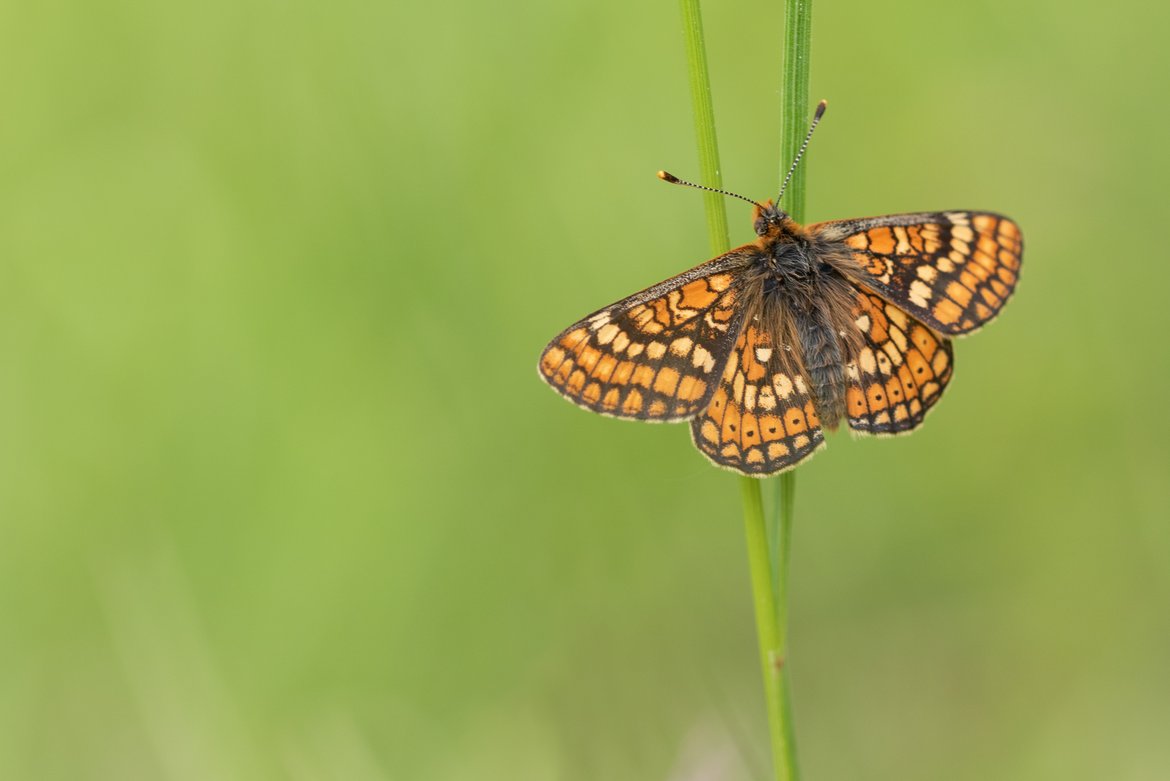
Marsh fritillary (Euphydryas aurinia)
Description and ecology
Conservation status: minor concern (Europe), critically endangered (Wallonia), endangered (Luxembourg)
The Marsh fritillary (Euphydryas aurinia) is a small butterfly (average wingspan 27 mm) frequenting a wide variety of open semi-natural environments with a particular requirement for their conservation status.
When viewed from above, the butterfly's wings are darker than when viewed from below. The wings are mainly orange with black spots on a dark yellow background. There are no black spots on the underside of the forewings.
This butterfly prefers poor, well-preserved environments (wet meadows, thistle forests, dry limestone grasslands, etc.). Within a perimeter of a few hectares, its habitat must be able to meet the following conditions: presence of host plants for its egg-laying, caterpillar-feeding plants in sufficient density; diversified nectar sources for the adults; and copses or sunny edges. Meadow Succix (Succisa pratensis), Field Knautie (Knautia arvensis) and Columbine Scabious (Scabiosa columbaria) can all be used as egg-laying host plants for this species, on which the caterpillars feed. This species flies in one generation, mainly from late April to July, and overwinters in the caterpillar stage.
Due to a lack of interconnection between its almost relict populations, which are present in too small, favourable environments, the Marsh fritillary has become one of the most threatened species in Wallonia. Too isolated, populations are all the less resistant to annual variations (weather, parasitism, etc.) and are gradually dying out, even on favourable sites.
In the context of the project
Within the project area, the species now survives only in wet meadows in the far east of Haute-Ardenne.
The project involves, on the one hand, the restoration of 48 hectares of meadows rich in Succises or Knauties (28 ha in the GDL and 20 ha in the RW), an essential habitat for the survival of the species. And secondly, the reintroduction of at least one metapopulation of the Marsh fritillary to favourable sites in Wallonia, located within its historical distribution.
Habitat description
Damson meadows are not included as such among the Natura 2000 habitat classification. However, they cover a multitude of variants included in various Natura 2000 habitats. They are the subject of restoration measures to encourage the presence of this butterfly, which mainly forages and lays its eggs on Meadow Succissa (Succisa pratensis). These grasslands develop on nutrient-poor (oligotrophic) soils, with a particular hygrometry with periods of water saturation alternating with dry periods (fluctuating water table). They are independent of altitude. Found at the bottom of valleys, but also on plateaux and slopes, these meadows require special management adapted to the life cycle of both the Succise and the butterfly. Mowing or grazing in a three-year rotation is an option that avoids destroying butterflies at the egg or caterpillar stage. Early annual mowing without hay collection in June (before the eggs hatch), with a mowing height of at least 20 cm is also compatible with the butterfly's ecology.
Some characteristic species
Pastures hosting the Marsh fritillary are rich in floristic species other than Succise (Succisa pratensis).
Species typical of :
hay meadows such as: Field Knautia (Knautia arvensis) and Centaureas (Centaurea spp.)
oligotrophic wet grasslands, including dioecious Valerian (Valeriana dioica)
or thin paratourbous grasslands, such as: Gentian pneumonanthe (Gentiana pneumonanthe)
© Corentin Thomas



